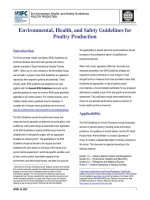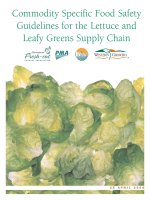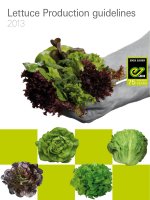Production guidelines for Lettuce docx
Bạn đang xem bản rút gọn của tài liệu. Xem và tải ngay bản đầy đủ của tài liệu tại đây (4.09 MB, 19 trang )
Production guidelines
Production guidelines
for Lettuce
for Lettuce
agriculture,
forestry & fisheries
D
e
p
a
rtm
e
nt:
A
g
riculture, Forestr
y
and Fisheries
REPUBLIC OF SOUT
H
AFRI
CA
Production guidelines
Production guidelines
for Lettuce
for Lettuce
Obtainable fro
m
Resource Centr
e
Directorate Agricultural Information Services
Private Bag X144, Pretoria, 0001 South Africa
Th
e
w
eb
: www.daff.gov.za
/
publication
s
P
ublished b
y
Directorate Agricultural Information Services
Department o
f
Agriculture, Forestry and Fisheries
Private Bag X144, Pretoria, 0001 South Africa
F
or
f
urther in
f
ormation please contact
Directorate Plant Production, Division Vegetable Cro
p
Tel:
0
12
3
1
9
60
7
2
Fax:
0
12
3
1
9
63
7
2
E-m
a
il: DP
P
@
daff.gov.za
Di
sc
l
a
im
e
r
This document has been compiled by the Department o
f
Agriculture, Forestry
and Fisheries and every e
ff
ort has been made to ensure accuracy and thor-
oughness o
f
the in
f
ormation contained herein and all liability
f
or any errors,
omissions or inaccuracies in such in
f
ormation and data
,
whether attributable
to inadvertence or otherwise. The Department o
f
Agriculture, Forestry and
F
isheries there
f
ore accepts no liability that can be incurred resulting
f
rom the
use
of
thi
s
in
fo
rm
a
ti
o
n.
CONTENTS
Part
i:
Part i:
General
aspects
General aspects
1
.
C
lassifi cation 1
2
. Origin and distribution 1
3
.
P
r
oduc
ti
o
n l
e
v
e
l
s
a
n
d
a
r
eas
1
4.
Description of the plant 1
5
.
C
ultivas 2
6
.
C
limatic requirements 3
7. Soil requirements 3
Part
ii
: Cultivation practices
1
. Propagation 3
2
. Soil preparation 3
3
.
P
lanting 3
4
.
Fe
rtili
sa
ti
o
n 4
5
.
I
rrigation 4
6
. W
eed
co
ntr
o
l 4
7.
Pes
t
co
ntr
o
l 4
8
. Disease control
5
9
. Other cultivation practices 7
10
. Harvesting 7
Part
iii
:
P
ost-harvest handlin
g
1
. Sorting and grading 7
2
.
P
acking
8
3
. Storage
8
4
. Transport
8
5
. Marketing
8
Part
i
v:
P
roduction schedules
8
Part v: Utilisatio
n
.
9
References
.
9
1
1
Part i: General
Part i: General
1. Classifi cation
Scientifi c name: L
ac
t
u
t
a
sa
tiv
a
L.
C
ommon names: Lettuce
,
Tshilai
F
amily: Astaraceae
/
Compositae
2. Origin and distribution
Lettuce probably originated
f
rom Asia, where it was grown
f
or centuries and
i
ts early forms were used in Egypt around 4500 BC. The Romans grew types
o
f
lettuce resembling the present romaine cultivars as early as the beginning
of the Christian era. The crop was also used in China by the 7
th
century A.D.
Lettuce is now one o
f
the world’s most important salad crops and is grown
w
o
rl
d
wi
de
.
3. Production levels and areas
3.1 South Africa
P
roductions levels are increasing in South Africa.
4. Description of the plant
The plant is a lacti
f
erous herb.
4.1. Stem
Lettuce has a shortened
fl
eshy stem 10 to 15 cm tall. The stem elongates and
branches in a paniculate manner during the reproductive phase. Each branch
terminates in a homogamous capitulum with ligulate, hermaphrodite pale yel-
lo
w l
ea
v
es
.
4.2 Leaves
I
t produces a rosette o
f
smooth, radical, spirally arranged leaves.
2
5. Cultivars
Lettuce is grouped into
f
our classes, namely loose-lea
f
, cos or romaine, butter
head
and
crisphead
or
head
lett
u
ce
.
head and crisphead or head lett ce
5.1 Crisphead or Iceberg lettuce
This type is widely grown in the country and it is characterised by
fi
rm heads
and crisp, curly leaves. The outer leaves are dark green, while the inner ones
are pale and lack chlorophyll. Cultivars in this group include Great Lakes, Del
R
io, Del Oro, Frosty, Wintercrisp and Winter Supreme that are cold tolerant.
Aviram, Commander, Tropical Emperor, Empire 2000, Summer Gold and Vic-
tory are cultivars within this group that are better adapted to warmer condi
-
tions. The cultivars are also well adapted
f
or
fi
eld growing and
f
or long-dis
-
tance shipments.
5.2 Butterhead lettuce
Th
e
bu
tt
e
rh
ead
l
e
tt
uce
fo
rm
s
a
h
ead
th
a
t i
s
so
m
e
h
o
w
s
imil
a
r t
o
th
a
t
of
cab-
bage in shape and has so
f
t, waxy,
fl
exible leaves. It is sensitive to hot weath-
er. Cultivars in this group include Kragramer Sommer and All Year Round.
Butterhead lettuce is more popular in Europe and is less adapted to
fi
eld
growing or long distance shipments.
5.3 Loose-leaf lettuce
This group does not
f
orm heads and is characterised by so
f
t leaves. It is rep
-
resented by cultivars such as Grand Rapids. It grows well both in the open
fi
eld and under protection and can be shipped over longer distances.
5.4 Cos or romaine lettuce
The cos lettuce has a loose head with narrow
,
so
f
t leaves. The outer leaves
are dark green, coarse and have heavy ribs while the inner
f
oliage is lighter.
3
3
I
t is more resistant to cold than the other groups. This type is usually grown in
op
en
fi
elds.
6. Climatic requirements
6.1 Temperature
Lettuce is a cool season crop that grows best within a temperature range o
f
12 °C to 20 °C. It does not suffer from light frosts and winter cold except near
m
aturity. Severe frost before harvest can scorch leaves and heads. Tempera-
tures above 27 °C affect head development and plant edible quality and also
promote premature seed stalk development. High temperatures also inhibit
germination and can cause a high incidence o
f
tipburn.
6.2 Rainfall
The crop has high moisture requirements and not more than 50 % o
f
the avail
-
able water in the root zone should be depleted be
f
ore irrigation.
7. Soil requirements
The plant grows well on a wide variety o
f
soils ranging
f
rom light sand to heavy
c
lay, whoever, best results are obtained on
f
ertile loams that are rich in or-
ganic matter. A pH between 5,5 and 7 is optimum. Lettuce should be grown
on soils with a high water-holding capacity and proper drainage for good root
growth and plant per
f
ormance.
Part ii: Cultivation practices
Part ii: Cultivation practices
1. Propagation
Lettuce is propagated
f
rom seed.
2. Soil preparation
Lettuce seed is small and as such requires soils that are not prone to crusting.
The soil should be worked to a
fi
ne tilth
,
without clods and it should be as
l
evel as possible in order to ensure a more uni
f
orm emergence.
4
3. Planting
R
aised beds are ideal
f
or lettuce production and they help prevent damage
from
soil
compaction
and
fl
ooding
.
The
y
also
impro
v
e
air
fl
o
w
aro
u
nd
the
from soil compaction and flooding The also impro e air flo aro nd the
plants, resulting in reduced disease incidence. Plant populations range from
60 000 to 100 000 per hectare.
Lettuce is regularly sown directly in the
fi
eld to a depth o
f
10 to 15 mm. The
seedlings are later thinned out to the desired spacing and they are sometimes
u
sed for transplanting. Seedlings for transplanting may also be raised in seed-
trays or seedbeds and transplanted about
fi
ve weeks a
f
ter sowing.
4. Fertilisation
F
ertiliser applications should be based on soil analysis. Overfertilisation with
n
itrogen may result in increased susceptibility o
f
the crop to various diseases
or disorders. Generally, a 2:3:4 (30) fertiliser mixture at a rate of 500 to 1 000
k
g
/
ha can be applied, depending on soil fertility. A side dressing of 150 to 250
k
g LAN per hectare can then be applied at
f
our weeks. Lettuce also responds
well to organic
f
ertilisers.
5. Irrigation
Lettuce has a shallow root system and as such requires
f
requent but lighter
i
rrigations. The roots penetrate the soil to a depth o
f
only 300 mm. Water
should be applied throughout the growing period and reduced when the heads
become
f
ull. A water shortage tends to promote bolting.
6. Weed control
Weeds are controlled mechanically, manually or chemically. Mechanical weed
c
ontrol can only be practised be
f
ore planting because o
f
close spacings.
Weeds are removed by hand hoeing or pulling between plants in the rows.
C
hemical control can be achieved through the application of propyzamide
shortly a
f
ter sowing, which can last 12 months and longer in the soil.
7. Pest control
Cutworms Agrotis spp.
C
utworms may be problematic during the seedling stage. They are usually
found two to fi ve cm below the soil surface in the vicinity of cut-off plants. Cut-
worms are active during the night and they cut the stems just above or below
th
e
so
il
su
r
face
.
5
5
CONTROL
•
Ba
it
s
• Chemical sprays
Aphids
Heavy populations o
f
aphids can result in stunted growth o
f
young plants.
Their presence may also contaminate the heads, thereby a
ff
ecting the ap
-
pearance o
f
the heads. Aphids act as vectors o
f
some viral diseases.
American bollworm
Larvae penetrate at the bottom o
f
leaves and eat their way into the heads.
CONTROL
• Chemical spray when the pest is notice
d
8. Disease control
Septoria leafspot (Septoria lactucae)
The disease is widespread and damaging in hot weather. In
f
ected plants have
small, yellowish spots on the outer leaves. These spots grow and become
l
arge, irregular and brown. The centre o
f
the spot is pale creamy brown with
m
any black dots.
SYMPTOMS
The disease is characterised by spots or patches o
f
white to grayish, talcum
-
powder like growth. Tiny, pinhead sized, spherical structures that are
fi
rst
white, later yellow-brown and
fi
nally black, may be present singly or in groups.
CONTROL
• Spraying with copper hydroxid
e
Downy mildew (Bremia lactucae)
Downy mildew occurs
f
riequently during cool, moist weather in spring or early
autumn and in cool
,
humid areas in summer.
6
SYMPTOMS
Light green or yellow lesions on the upper sur
f
ace o
f
the leaves are
fi
rst no-
ticed on older leaves. The lesions later become necrotic, limited by veins and
angular. A white downy mould is also noticed on the lower lea
f
sur
f
ace.
CONTROL
P
lanting resistant cultivars. Use disease-
f
ree seeds. Always practise crop ro-
t
a
ti
o
n.
Powdery mildew (Erysiphe cichoracearum)
The disease occurs
f
requently and it reduces the quality o
f
the crop.
SYMTOMS
The disease is characterised by spots or patches o
f
white to greyish, talcum
-
powder-like growth. Tiny, pinhead-sized, spherical structures that are
fi
rst
white, later yellow-brown and
fi
nally black, may be present singly or in group.
CONTROL
• Crop rotation, especially with non-host crops. Use disease-free seeds and
always try to plant disease-resistant cultivars.
Sclerotinia rot
SYMPTOMS
I
n
f
ected plants initially wilt on hot days. A severe wet rot is seen on the stem
n
ear the soil. This rot spreads to the roots and into the head, which becomes
wet and slimy. A white, cottony mould develops on rotted tissue. Hard, irregu
-
l
ar
,
black sclerotia can be seen in the white mould and rotted tissue. The
outer leaves wither and drop
fl
at,
f
ollowed by the inner ones, i
f
the base o
f
the
leaf
h
as
r
o
tt
ed
.
CONTROL
• Rotation with non-host plants such as onions. Always strive to plant dis-
ease-resistant cultivars. Use only registered chemicals.
Bacterial rot complex
7
7
The disease is caused by a combination o
f
bacteria that occur on the lea
f
sur
f
aces without causing damage. The bacteria get into the leaves and cause
rotting
when
the
plant
is
stressed
or
damaged
.
rotting when the plant is stressed or damaged
SYMPTOMS
Symptoms are leafspots which start off under water-soaked conditions and
l
ater turn brown, be
f
ore developing so
f
t head rot and dying.
CONTROL
Use disease-
f
ree seeds and always try to plant disease-resistant cultivars.
Discard in
f
ested plants and remove these
f
rom the
fi
eld. Always keep your
fi
e
l
d
f
r
ee
of
w
eeds
.
Lettuce mosaic virus
The disease is seed-borne and is transmitted by the green peach aphid.
SYMPTOMS
Vein clearing
f
ollowed by mottling, recurving o
f
the leaves and increased mar
-
ginal
f
rilliness results
f
rom early in
f
ections. In
f
ected, mature plants are yellow
a
n
d
s
t
u
nt
ed
a
n
d
ca
nn
o
t
be
h
a
rv
es
t
ed
.
CONTROL
Use disease-
f
ree seeds and always try to plant disease-resistant cultivars.
Always keep your
fi
eld
f
ree o
f
weeds.
Part ii: Other cultivation practices
Part ii: Other cultivation practices
9. Harvesting
9.1 Harvest maturity
The heading types are harvested when the heads are
f
ully grown and
fi
rm
while the loose-lea
f
types are picked when the leaves have reached the re-
quired size.
8
9.2 Harvesting methods
Lettuce is harvested by hand by cutting o
ff
the plant just above the soil sur
f
ace
to keep most o
f
the outer leaves around the head. Harvesting should be done
v
ery early in the morning because lettuce wilts rapidly.
Part iii: Post-harvest handling
Part iii: Post-harvest handling
Lettuce contains more than
95
% water and has a short shel
f
li
f
e. There
f
ore
the crop should be moved into a cool, airy, shady area
f
ree
f
rom strong winds
directly a
f
ter harvesting.
1. Sorting and grading
Leaves that are loose, discoloured, damaged, soiled and diseased are re-
m
oved. The butt ends are cut cleanly
f
or packing. Lea
f
, butterhead and cos
types are cut, trimmed and tied into compact bundles be
f
ore being placed in
c
artons. Lettuce is graded according to head size. Good quality lettuce is free
f
rom wilting, seeding or bitter taste and is
fi
rm,
f
resh, clean and crispy.
2. Packing
P
acking may be done in the
fi
eld or in a packing shed. Lettuce is packed in
two-or
f
our-layered crates or cartons and packed according to head-size
groups.
3. Storage
Lettuce can be stored for three weeks if kept at 0,5 °C to 4 °C and 95 % relative
h
umidity. It should not be stored with products that give o
ff
ethylene, such as
apples, pears or cantaloupes, because ethylene increases russet spotting.
The crisp head and cos lettuce types have a longer shel
f
li
f
e than the butter
h
ead and the loose-lea
f
types.
4. Transport
Lettuce should be transported in re
f
rigerated vehicles. A controlled atmos
-
phere o
f
2 % carbon dioxide and 3 % oxygen is recommended i
f
lettuce has to
be shipped to long-distance markets
f
or a month. It is said that the reduction
i
n decay achieved by 2 % carbon dioxide outweighs the danger o
f
damage.
9
9
Part v: Utilisation
Part v: Utilisation
Lettuce is used mainly in salads but the leaves may even be boiled like spin-
ach. It is also commonly used in sandwiches. In some parts o
f
the world, the
l
eaves are used to make a cigarette that does not contain nicotine. Seeds of
a primitive
f
orm
f
ound in Egypt are used to manu
f
acture some edible oil. A
sleep-inducing medicine is manu
f
actured
f
rom latex
f
ound in
Lac
t
u
t
a
vir
osa
L.
ACTIVITIES
JANUARY
FEBRUARY
M
ARCH
APRI
L
M
AY
JUN
E
JULY
AUGUST
S
EPTEMBE
R
O
CTOBE
R
N
OVEMBE
R
DECEMBE
R
Soil sampling
X
X
X
X
Soil preparatio
n
X
X
X
X
X
X
P
lantin
g
XX
X
X
Fe
rtili
sa
ti
on
XX
X
X
X
I
rrigatio
n
XX
X
XX
Pes
t
co
ntr
o
lXX
X
XX
Di
sease
co
ntr
o
lXX
X
XX
W
eed
co
ntr
o
l
X
XX
X
Lea
f
samplin
g
Harvestin
g
X
X
X
X
X
Marketin
g
X
X
X
X
X
X
Part iv: Utilisation
Part iv: Utilisation
5. Marketing
Lettuce is marketed in the
f
resh produce markets or directly to retailers.
REFERENCES
Had
fi
eld
,
J. 1995.
T
he A – Z of Vegetable Gardening in South Afric
a
.
Struikhof Publishers. Cape
T
o
wn.
Hartmann, H.T., Ko
f
ranek, A.M., Rubatzky, V.E. & Flocker, W.J. 1988. Plant Science: Growth
,
D
evelopment and Utilization of Cultivated Plant
s
.
2nd Edition. Regents
/
Prentice Hall. New
Jersey.
h
ttp://oregonstate.edu/Dept/NWREC/lettuce.html
KwaZulu-Natal Department o
f
Agriculture and Environmental A
ff
airs. 2001. Vegetable production
guidelines
f
or KwaZulu-Natal. Pietermaritzburg.
R
yder , E.J. 1986. Lettuce Breeding. Page 436 – 472. In:
B
reeding Vegetable Crop
s
.
Bassett
,
M.J.
(
Ed). AVI Publishing Company, Inc. Connecticut.
Trench, T.N., Wilkinson, D.J. & Esterhuysen, S.P. 1992. South African Plant Disease Contro
l
H
a
n
dbook
. Farmer Support Group, University of Natal. Pietermaritzburg.
kk
www.ext.colostate.edu
/
pubs
/
garden
/
02 902.html
Notes
Notes









